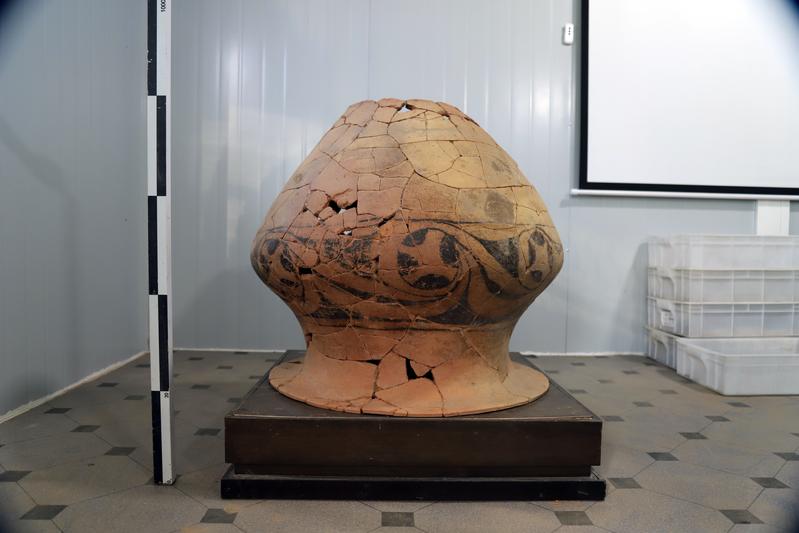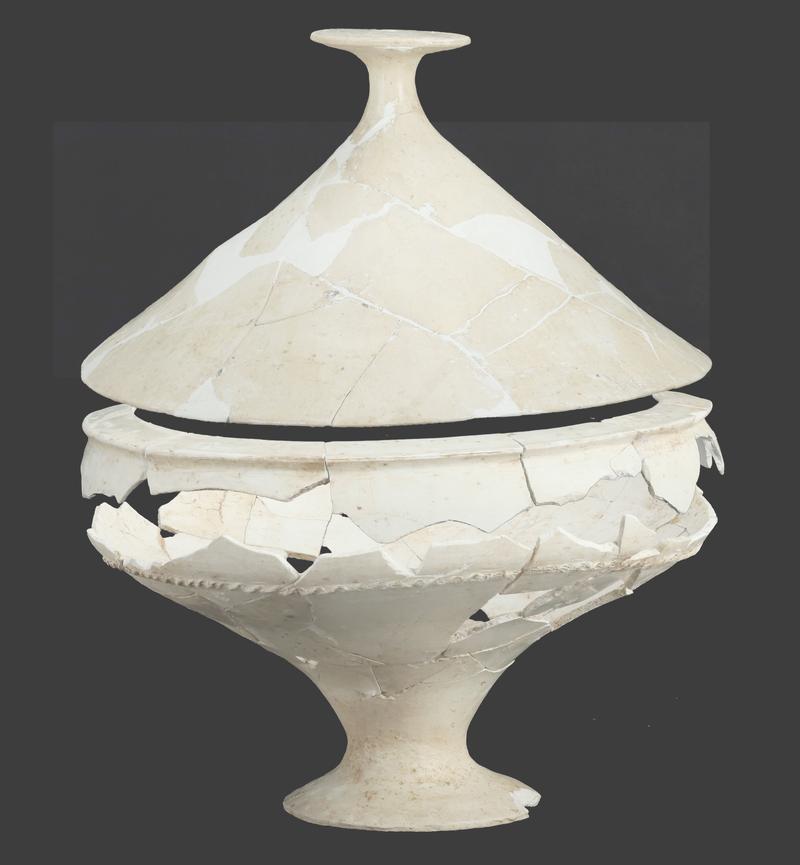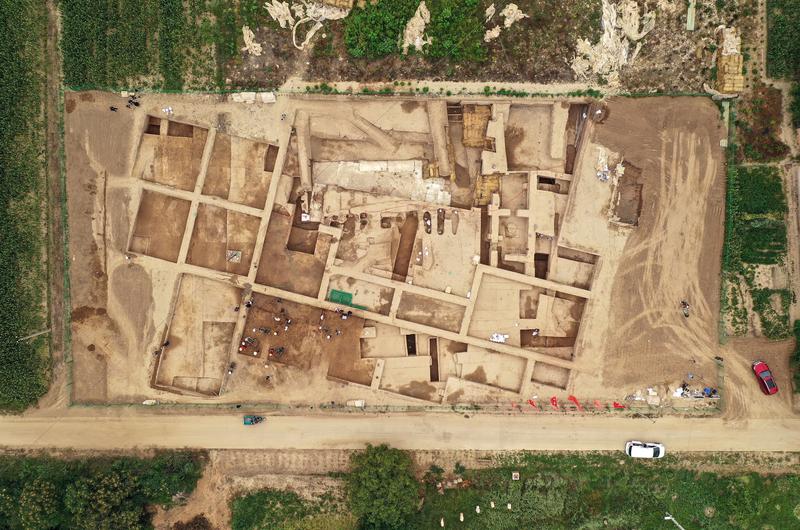Discoveries at Nanzuo site offer stunning glimpse into a well-organized and functioning society, Wang Ru reports.
 Different sizes of ceramic pots, a white pottery vessel, a painted jar and bottles unearthed at the Nanzuo site in Gansu province. (PHOTO PROVIDED TO CHINA DAILY)
Different sizes of ceramic pots, a white pottery vessel, a painted jar and bottles unearthed at the Nanzuo site in Gansu province. (PHOTO PROVIDED TO CHINA DAILY)
Editor's note: A national comprehensive research program, launched in 2002, to trace the origins of Chinese civilization, has led to the excavations and studies of key sites that are about 3,500 to 5,500 years old. It has revealed a host of secrets about ancient China, including how early civilizations were formed and how they merged to create unity in diversity. China Daily speaks to experts working at these sites to decode their recent discoveries.
The Palace Museum in Beijing, China's imperial palace from 1420 to 1911, attracts numerous visitors to admire its grand scale, precise layout and magnificent architecture. But on the Loess Plateau, there is a long-forgotten site that is home to a large-scale palace-like complex with a similar layout — a central axis and evenly distributed rammed earth terraces. This one, however, was built by ancient people about 5,000 years ago.
The Nanzuo site, located in Nanzuo village, on the Dongzhi plateau in Qingyang city, Northwest China's Gansu province, was first found in a national survey of cultural relics in 1958. Then, in the 1980s and '90s, six archaeological missions were carried out on the site, and the main structure, which was named F1 (No 1 house ruins), was discovered. At the time, though, it didn't arouse much interest and the size and significance of the site remained a mystery.
However, some insightful people, like archaeologist Yan Wenming, an expert in Neolithic archaeology, saw the site's potential. Yan often said Nanzuo was of vital importance, but just how important had yet to be confirmed.
 Different sizes of ceramic pots, a white pottery vessel, a painted jar and bottles unearthed at the Nanzuo site in Gansu province. (PHOTO PROVIDED TO CHINA DAILY)
Different sizes of ceramic pots, a white pottery vessel, a painted jar and bottles unearthed at the Nanzuo site in Gansu province. (PHOTO PROVIDED TO CHINA DAILY)
Yan's emphasis urged Han Jianye, a former student of his and a professor at Renmin University of China, to conduct a survey on the site in 2020, which led to a new round of archaeological studies. Last year, an archaeological team, led by Han, was formed by the Gansu Provincial Institute of Cultural Relics and Archaeology and Renmin University of China, among others.
Employing multidisciplinary methods, excavation, chronological studies and technological analysis of pottery, as well as flora and fauna and environmental archaeological studies, have since been undertaken.
The latest study shows the site dates to between 4,700 and 5,200 years ago. Its core area, encircled by nine terraces, has an area of 30 hectares and belongs to the late period of the Yangshao Culture, dating back 4,700 to 7,000 years across the northern part of China.
Discovered in 1921 in Yangshao village, Henan province, Yangshao has been known as a site for Neolithic culture along the middle reaches of the Yellow River. That discovery represents the birth of modern archaeology in China.
According to Zhang Chi, a professor at the School of Archaeology and Museology, Peking University, the general scale of Nanzuo is unprecedented.
"Nanzuo site is twice the size of the extant Erlitou site (widely believed to be the capital of the late period of the Xia Dynasty, which ran from around the 21st century to the 16th century BC). Its area is similar to the size of that at Liangzhu (a Neolithic site in the Yangtze River Delta)," says Zhang.
 Different sizes of ceramic pots, a white pottery vessel, a painted jar and bottles unearthed at the Nanzuo site in Gansu province. (PHOTO PROVIDED TO CHINA DAILY)
Different sizes of ceramic pots, a white pottery vessel, a painted jar and bottles unearthed at the Nanzuo site in Gansu province. (PHOTO PROVIDED TO CHINA DAILY)
Han says the site is a high-level settlement which may have functioned like a capital in the past.
"The core area is located at the center of the whole site, the 'palace' area is in the center of the core area, and the main structure, F1, is in the center of the 'palace' area with a central axis. The strict layout, which is very close to those in capitals and palaces of the later dynasties, has never been found at other sites contemporaneous with Nanzuo," says Han.
With a southern exposure, the main building, F1, has a total area of more than 800 square meters, and the internal floor space is more than 630 sq m. It is divided into an antechamber and a rear hall, with three doors.
"Architecture in later dynasties often shows such a layout as well. The middle door is believed to be holy and not one that is normally used, and the two on the sides are subordinate," says Han.
He also mentions that architecture found at the Dadiwan site, a prehistoric site dating back 4,800 to 8,000 years in Gansu, has such a design, too, although the structure is much smaller in size than that of Nanzuo.
East of F1 is a space named F2, believed to be a place of sacrifice, from which archaeologists have unearthed stunning cultural relics, like exquisite white and black pottery that has never been found on the Loess Plateau, and a large amount of carbonized rice.
"Some parts of the white pottery are as thin as eggshells. We don't know how ancient people made them," says Li Xiaolong, a member of the Nanzuo archaeological team, who is also an assistant professor at the Institute of Culture and Heritage of the Northwestern Polytechnical University in Xi'an, Shaanxi province.
 Different sizes of ceramic pots, a white pottery vessel, a painted jar and bottles unearthed at the Nanzuo site in Gansu province. (PHOTO PROVIDED TO CHINA DAILY)
Different sizes of ceramic pots, a white pottery vessel, a painted jar and bottles unearthed at the Nanzuo site in Gansu province. (PHOTO PROVIDED TO CHINA DAILY)
Zhang Xiaoning, a member of the Nanzuo archaeological team, who is from the Gansu Provincial Institute of Cultural Relics and Archaeology, further explains: "Skills to make white pottery, and even kaolin, the raw material, have rarely been found on the Loess Plateau before.
"The black pottery may be related to the Qujialing Culture, dating back 4,500 to 5,100 years in the middle and lower reaches of the Yangtze River. Maybe there was some transportation or a trade route at that time."
Another perplexing discovery is the carbonized rice. "Such a large amount of rice found in the Yellow River basin, it's unprecedented and unbelievable," says Han.
According to him, the main crops in Gansu should be millet, and its scarcity is what made rice precious. People used the precious crops for sacrifice. Maybe rice was collected in administrative ways, but the possibility that it could be planted locally at that time cannot be excluded.
The team is researching the origin of the rice. "If it was planted locally, it is valuable for us in relation to studies of the early agriculture on the Loess Plateau. If it came from somewhere else, we can infer there was probably a tribute system, involving transportation and trade," says Zhang Xiaoning.
 A bird's-eye view of the "palace" area of the Nanzuo site. (LI HE / XINHUA)
A bird's-eye view of the "palace" area of the Nanzuo site. (LI HE / XINHUA)
The cultural relics are thought to be of a high level, which means they were used in rituals and sacrifices, instead of in daily life. "People who study civilizations have a consensus, that the early stage of a civilized society is a theocracy, and then it gradually evolves into a monarchal one. Therefore, sacrifice could help early leaders to strengthen their power, and became very important in early societies," says Han.
Other pieces of evidence that may support the theory that Nanzuo was a capital are red arrowheads made of stone and bone and covered with cinnabar. Western Zhou Dynasty (c. 11th century-771 BC) literature records show emperors at that time awarded feudal princes with red arrows, granting them the power to kill. The arrowheads found in Nanzuo may have had a similar function, symbolizing military power.
Nine giant terraces are formed around the core structure. One is on the central axis, and the other eight are distributed in a symmetrical way along the axis. "Each terrace covers more than 1,000 sq m," says Han.
The original height of the terrace is not clear, but the remaining part is three or four meters. "If it was a dozen meters high, with a smaller top, it would be like there were nine pyramids originally," he adds.
The terraces are surrounded by moats. Archaeologists have excavated and studied part of a moat around No 1 terrace, and have worked out the huge labor required to build it.
"The moat is 20 meters wide and 10 meters deep. After excavation, the bottom and two sides were built up with three to four meters of rammed earth to avoid soil erosion. We believe there was really water flowing inside, or the rammed earth would not have been necessary. It can be regarded as part of a grand-scale water conservation project," says Han.
He mentions that to complete such moats, the labor required may be even more than that involved in the building of the F1 and the terraces. "The large-scale project required a great amount of manpower and material resources, and that must be realized through a powerful leader," Han says. "The presence of monarchy indicates the appearance of civilization."
According to Zhang Xiaoning, social division was very obvious. Around the site, by the side of Dongzhi plateau, there are cave dwellings that are thought to have been the homes of ordinary people, where daily-use pottery has been found that is much different from such items found in F2.
"In the cave dwellings we have found pots and pans, but those at the main site are obviously ritual pottery. The difference between a higher class and ordinary people is easy to spot," says Zhang Xiaoning.
According to Han, Nanzuo site is of unique importance, and reflects a strong social and public power, showing that the east of the Liupan Mountains entered an early state or civilized society stage. "This is of great value as evidence in proving that Chinese civilization has a history of more than 5,000 years," says Han.
Alongside the remains of F1 there appears to be wing rooms on the left and right. Archaeologists guess that maybe people of high social status once lived there. So far though, that remains a theory, since it appears that one day they abandoned the "palaces", cleaning up without leaving a trace, and flattened the building, making it a foundation upon which new structures were built.
Located to the east of the Liupan Mountains, Nanzuo seems to have a relationship with the Dadiwan site, which is to the west. According to Li, both sides of the mountain range seem to play a big role in the origin and formation of the Chinese civilization.
Contact the writer at wangru1@chinadaily.com.cn


